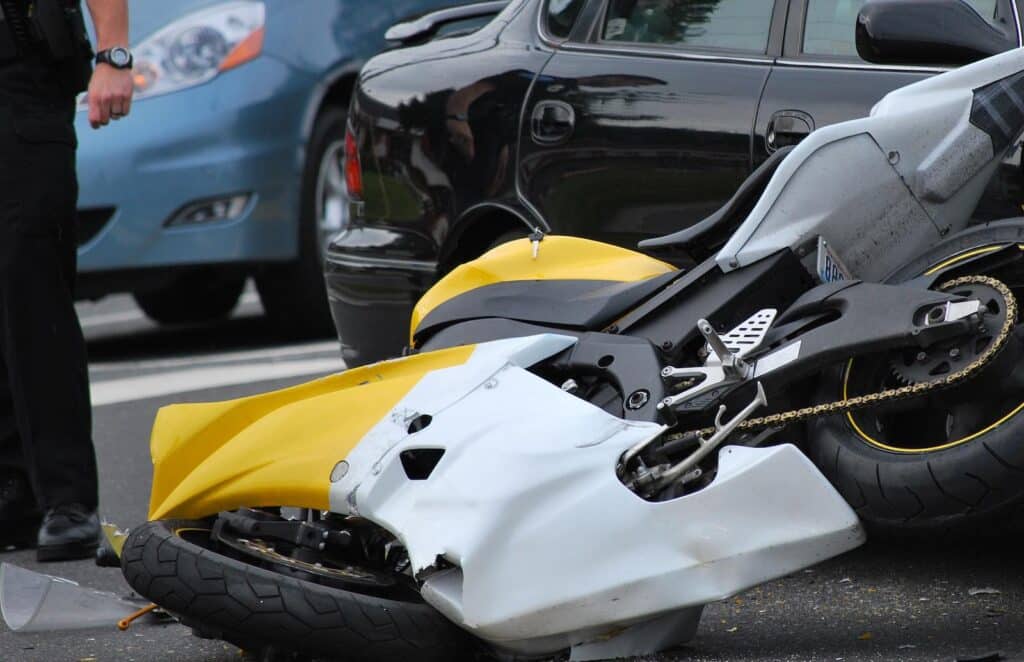Riding a motorcycle can be an exhilarating experience, but it’s essential to prioritize safety and be aware of the laws governing motorcycle helmet usage. Utah, like other states, has specific motorcycle helmet laws designed to protect riders from potentially life-threatening injuries. As a rider in Utah, it’s crucial to understand these laws, as well as the risks associated with motorcycle accidents and the importance of wearing protective gear.
We’re exploring the motorcycle helmet law Utah has in place, discussing the importance of wearing a helmet, outlining common injuries sustained in accidents, and racing into the role of protective gear. We’ll also touch on how Utah motorcycle accident attorneys can help victims pursue compensation for their injuries. So, buckle up, and let’s start those engines!
Key Takeaways
- Ride responsibly in Utah: riders under 21 must wear a helmet, those over 21 can choose not to if they’ve completed a safety course.
- Wear protective gear like helmets and eye protection to reduce risk of head injuries & fatalities from motorcycle accidents.
- Motorcycle accident attorneys can help prove negligence and pursue fair compensation for damages suffered.
Utah’s Motorcycle Helmet Laws: What You Need to Know
In Utah, riders under 21 years of age are required to wear a helmet when operating or riding a motorcycle on the highway. However, motorcyclists over 21 can choose not to wear a helmet if they have completed a motorcycle safety course. Violating Utah’s helmet laws can result in fines up to $50 and/or up to 90 days in jail.
Wearing a helmet helps riders comply with the law and dramatically cuts down the risk of head injuries if an accident occurs.
Helmet Age Requirements and Exceptions
Utah’s helmet law specifies that riders under 21 must wear a helmet when riding a motorcycle on the highway to prevent head injury. This age requirement aims to protect young riders who may be more vulnerable to accidents and injuries. The U.S. Department of Transportation strongly recommends universal helmet laws that require all motorcyclists, regardless of age or speed, to wear head protection, as it can help prevent:
- head injuries
- traumatic brain injuries
- skull fractures
- facial injuries
- upper extremity injuries
There are exceptions to Utah’s helmet law for riders over 21 years of age. These individuals are not required to wear a helmet if they have completed a motorcycle safety course. This exception acknowledges that experienced riders who have undergone safety training may pose a lower risk of accidents and injuries on the road.
Penalties for Violating Helmet Laws
Not following Utah’s helmet law can lead to consequences, including fines and penalties. Fines for violating the helmet law can reach up to $50, and in some cases, riders may face up to 90 days in jail. These penalties serve as a deterrent for riders who may otherwise neglect helmet usage, putting themselves and others at a higher risk of injury in a motorcycle accident.
Comprehending and adhering to Utah’s helmet laws helps riders dodge fines, penalties, and potential injuries. Helmet use, combined with other safety precautions, can greatly lower the risk of severe injuries and traffic fatalities for motorcyclists.
The Importance of Wearing a Helmet in Utah
Wearing a helmet while riding a motorcycle in Utah is crucial for reducing head injuries and lowering fatality rates in accidents. Helmets provide a layer of protection for the rider’s head and can absorb some of the impact during a crash, reducing the severity of head injuries.
In addition to complying with the law, wearing a helmet demonstrates a commitment to safety and responsible riding practices.
Reducing Head Injuries
Helmets play a vital role in reducing head injuries among motorcyclists. In fact, wearing a helmet can decrease the risk of head injuries by 69%. Traumatic brain injuries (TBIs) are among the most frequent head injuries resulting from motorcycle accidents in Utah. These injuries can have severe and long-lasting consequences for riders, affecting their cognitive and motor functions.
Helmet use can dramatically lower the chance of riders sustaining a TBI or other head injury during an accident. Given the high risk of head injuries in motorcycle accidents, helmet usage should be a priority for riders to safeguard themselves and decrease the likelihood of life-changing consequences.
Lowering Fatality Rates
Helmet use is also associated with a lower fatality rate among motorcyclists. Studies have shown that wearing a helmet can reduce the risk of death in a motorcycle accident by 37%. This decrease in fatalities underscores the importance of helmet usage for rider safety.
In addition to wearing a helmet, riders can take other safety measures to further reduce the risk of fatalities in accidents. These include wearing proper protective gear, such as jackets, gloves, and boots, taking a motorcycle safety course, and obeying speed limits. Following these safety practices can greatly decrease motorcyclists’ risk of injury or death on the road.

Common Injuries from Motorcycle Accidents in Utah
Motorcycle accidents in Utah often result in motorcycle accident injuries, such as traumatic brain injuries, spinal cord injuries, and broken bones or fractures, sometimes caused by blunt force trauma. These injuries have the potential to cause severe, long-term physical and emotional consequences for motorcycle accident victims and their families.
Understanding the risks associated with motorcycle accidents and the importance of safety measures, such as wearing helmets and protective gear, is crucial for riders in Utah.
Traumatic Brain Injuries
Traumatic brain injury is a common and severe consequence of motorcycle accidents. These injuries can result from a sudden blow to the head, causing damage to the brain and potentially leading to long-term cognitive and motor impairments. Some key points to note about traumatic brain injuries in motorcycle accidents are:
- They can occur from a sudden blow to the head
- They can result in long-term cognitive and motor impairments
- Accidents involving larger motorcycle engine sizes are more likely to cause brain injuries.
Symptoms of TBIs from motorcycle accidents can include:
- Loss of consciousness
- Headaches
- Vomiting or nausea
- Difficulties with speech
- Dizziness
- Confusion
- Unusual behavior
- Decreased motor function
- Convulsions
- Seizures
- Coma
The potential for such devastating consequences in a motorcycle crash highlights the importance of helmet usage and other safety precautions for injured motorcyclists, especially motorcycle riders, in light of reported motorcycle crashes.
Spinal Cord Injuries
Spinal cord injuries, also known as spinal injuries, are another serious type of injury that can occur in motorcycle accidents. These injuries can lead to partial or complete paralysis, long-term disability, and significant changes in a person’s quality of life. Symptoms of spinal cord injuries may include loss of feeling, lack of mobility, and breathing difficulties.
Treatment for spinal cord injuries may involve:
- Physical therapy
- Medications
- Surgery
- Other interventions to help with pain management and mobility improvement
The severity and life-altering consequences of spinal cord injuries underscore the importance of wearing a helmet and practicing safe riding habits.
Broken Bones and Fractures
Fractures and broken bones are frequent injuries sustained in motorcycle accidents. The National Highway Traffic Safety Administration (NHTSA) reports that motorcyclists involved in collisions often experience:
- Bone fractures in the legs
- Broken bones in the arms, wrists, and ribs
- Facial fractures
- Skull fractures
A serious injury can have serious consequences and may require medical treatment and rehabilitation.
The consequences of fractures and broken bones in motorcycle accidents can be severe, leading to disfigurement, permanent nerve damage, and disability. These outcomes emphasize the importance of wearing helmets, protective clothing, and practicing safe riding habits to minimize the risk of injury.
Protective Gear for Utah Motorcyclists
In addition to wearing a helmet, Utah motorcyclists should also consider using other protective gear to enhance their safety on the road. Proper clothing and eye protection can play a crucial role in preventing injuries and ensuring a safer riding experience.
Proper Clothing
Wearing appropriate clothing while riding a motorcycle can help minimize injuries in the event of an accident. Protective clothing made from man-made materials or leather can offer additional protection against abrasions, road rash, and other injuries. Full body protective motorcycle jackets, pants, and gloves can shield riders from potential hazards on the road, while heavy boots can provide added protection for the feet and ankles.
Investing in suitable clothing can greatly decrease riders’ chances of sustaining severe injuries in an accident. Pairing the right clothing with helmet usage and other safety measures contributes to Utah motorcyclists’ safety on the road and reduces injury risks.
Eye Protection
Eye protection is essential for maintaining clear vision and avoiding debris while riding. Although not required by law, it’s a good idea for Utah motorcyclists to wear eye protection such as a face shield or goggles. Clear vision is crucial for identifying potential hazards on the road and reacting appropriately to avoid accidents.
Selecting the right fit and taking care of your eye protection ensures its effectiveness and comfort. By incorporating eye protection into their riding gear, motorcyclists can enhance their safety and reduce the risk of eye injuries on the road.

How Utah Motorcycle Accident Attorneys Can Help
Utah motorcycle accident attorneys can help accident victims prove negligence and pursue fair compensation for their injuries. Following an accident, seeking legal advice and representation is vital to safeguard your rights and improve your chances of securing deserved compensation.
Proving Negligence
Attorneys can assist in establishing the at-fault party’s negligence in a motorcycle accident. To prove negligence, the following evidence must be presented:
- Duty of care: Demonstrating that the at-fault party owed a duty of care.
- Breach of duty: Showing that the at-fault party failed to uphold their duty of care.
- Causation: Establishing a direct link between the at-fault party’s breach of duty and the accident.
- Damages: Providing evidence of the damages suffered as a result of the accident.
These elements are essential for a successful negligence claim.
Experienced motorcycle accident attorneys can help in the following ways:
- Identifying the negligent party by collecting evidence, talking to witnesses, and dealing with insurance companies
- Providing professional legal representation greatly boosts your chances of establishing negligence
- Assisting in securing the compensation you merit
Pursuing Fair Compensation
Legal representation can help victims obtain the compensation they deserve for their injuries and losses. Compensation may cover:
- Repair costs
- Fair market value of damaged items
- Economic losses
- Compensatory damages awarded in Utah courts
Attorneys can provide valuable advice and guidance on the best steps to take to get the compensation you deserve. They can also help victims understand the legal system, ensure their rights are respected, and navigate the complex process of pursuing a negligence claim.
If you or a loved one has been injured in a motorcycle accident, contacting our team at Palmer Litigation Injury Attorney is a vital step in pursuing fair compensation.
Summary
In conclusion, understanding and adhering to Utah’s motorcycle helmet laws is essential for rider safety. Helmets play a critical role in reducing head injuries and lowering fatality rates in accidents, while proper protective gear can further minimize injuries and enhance rider safety.
Utah motorcycle accident attorneys can help victims prove negligence and pursue the compensation they deserve for their injuries. By taking appropriate safety measures and seeking legal representation when needed, Utah motorcyclists can significantly reduce the risk of injury and protect themselves on the road.
Frequently Asked Questions
Is it illegal to ride a motorcycle without a helmet in Utah?
Riders under 21 are required to wear a DOT-approved helmet while riding a motorcycle in Utah, whereas riders 21 and over have the option of wearing a helmet or not. However, it is strongly encouraged that all riders wear a helmet when riding a motorcycle.
What are the new motorcycle laws in Utah?
In May 2019, Utah passed a law allowing lane filtering for motorcyclists. This means they can overtake and pass another vehicle stopped or moving in the same direction by riding between two lanes.
What is the 5-year rule for motorcycle helmets?
The Five-Year Rule recommends that you replace your helmet every five years. This is a consensus among the Snell Foundation and helmet manufacturers, with Consumer Reports suggesting replacing your helmet after five years “out of an abundance of caution.” However, if your helmet is in good condition, some bike safety advocates say holding on to it longer won’t necessarily put you at significant risk.
How much compensation do you get for a motorcycle accident?
The compensation you can receive for a motorcycle accident varies depending on the severity of the injuries and other factors but typically ranges from around $9,000 to millions of dollars. On average, settlements are around $73,700. With the help of an experienced attorney, you can get the maximum compensation you deserve.
How can wearing a helmet reduce head injuries and fatality rates in accidents?
Wearing a helmet can significantly reduce the risk of head injuries and fatalities in accidents; with up to 69% decreased risk of head injuries and 37% decreased risk of death.




